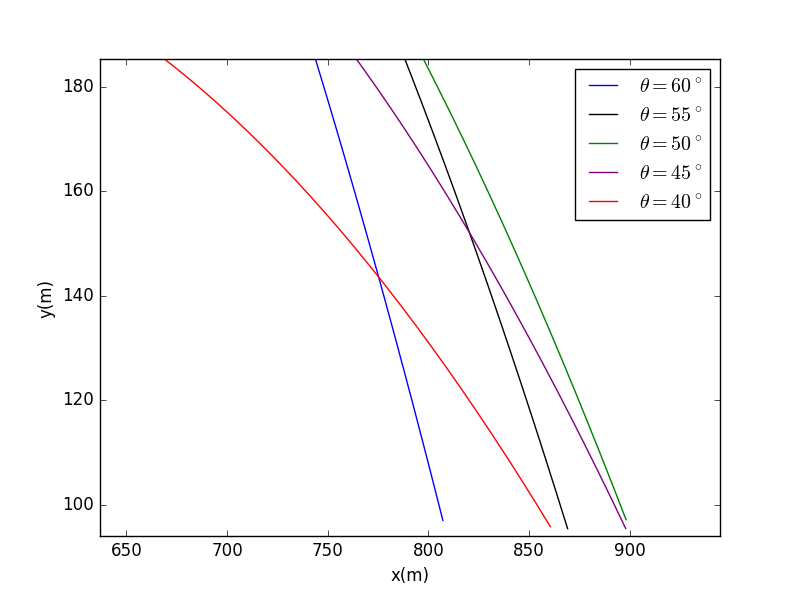@oliver1995
2016-10-24T06:04:22.000000Z
字数 2654
阅读 790
Exercise_06: The Trajectory of a Cannon Shell(2)
Abstract
- use python to do homework 2.10
- add the air resistance and the wind velocity
Background
- Genenralize the program developed for the previous problem so that it can deal with situations in which the target is at a different altitude than the cannon.Consider cases in which the target is higher and lower than the cannon.Also investigate how the minimum firing velocity required to hit the target varies as the altitude of the target is varied.(consider the wind velocity)
Main body
First considering the wind velosity
import pylab as plfrom math import *class cannon:def __init__(self,init_v=100,B_m=0.00004,theta = 60,init_x=0,init_y=0,time_step=0.1,wind_velocity=-10):self.vx = [init_v*cos(theta*2*pi/360)]self.vy = [init_v*sin(theta*2*pi/360)]self.x = [init_x]self.y = [init_y]self.t = [0]self.B_m = B_mself.win = wind_velocityself.dt = time_stepdef run(self):while self.y[-1]>=0:self.x.append(self.x[-1] + self.dt * self.vx[-1])self.y.append(self.y[-1] + self.dt * self.vy[-1])f=sqrt((self.vx[-1]-self.win)**2+self.vy[-1]**2) * self.B_mself.vx.append(self.vx[-1] - self.dt * f *(self.vx[-1]-self.win))self.vy.append(self.vy[-1] - self.dt * (9.8 + f *self.vy[-1]))def show_results(self):pl.plot(self.x, self.y,color="black",linestyle="-.",label="headwind")pl.xlabel('x(m)')pl.ylabel('y(m)')pl.legend(loc='upper right')pl.ylim(0)pl.show()a = cannon()a.run()a.show_results()

Then considering the altitude and height
when height =-100:
code:
import pylab as plimport mathclass cannon:def __init__(self,init_v=100,B_m=0.00004,theta = 35,init_x=0,init_y=0,time_step=0.1,wind_velocity=10,a_0=0.0065, alpha_0=2.5, temp_0=298.0,height=-100):self.vx = [init_v*math.cos(theta*2*math.pi/360)]self.vy = [init_v*math.sin(theta*2*math.pi/360)]self.x = [init_x]self.y = [init_y]self.t = [0]self.B_m = B_mself.a =a_0self.alpha=alpha_0self.temp=temp_0self.win = wind_velocityself.height=heightself.dt = time_stepdef run(self):while self.y[-1]>=self.height:self.x.append(self.x[-1] + self.dt * self.vx[-1])self.y.append(self.y[-1] + self.dt * self.vy[-1])rho = (1- self.a *self.y[-1]/ self.temp ) ** self.alphaf=math.sqrt((self.vx[-1]-self.win)**2+self.vy[-1]**2) * self.B_m * rhoself.vx.append(self.vx[-1] - self.dt * f *(self.vx[-1]-self.win))self.vy.append(self.vy[-1] - self.dt * (9.8 + f *self.vy[-1]))def show_results(self):pl.plot(self.x, self.y,color="blue",linestyle="-", label="35")pl.xlabel('x(m)')pl.ylabel('y(m)')pl.legend(loc='upper right')pl.ylim(-100)pl.show()a = cannon()a.run()a.show_results()


when height =100m:


Conclusion
- From the picture, we can easily see that when height is -100, it is that the farthermost the cannon hit,a little smaller than 45°. And when the heigtt is 100, hit the farthermost, a little biger than 45°.
- Adding some realistic factor make the code more comflex, but the model will be more accurate
Acknowledgement
- Thanks to teacher cai's ppt.
